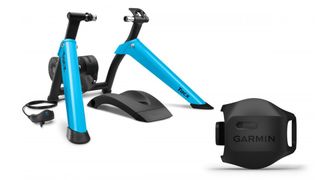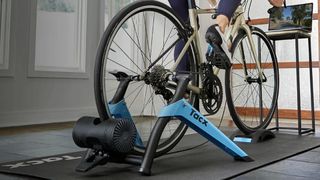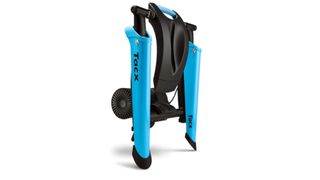Here's the Tacx Boost Bundle review in a sentence, if you're in a real hurry: this budget turbo trainer is about as affordable as turbos from big-name brands get, but still quite hard to recommend.
Tacx, which is part of Garmin, make a wide range of indoor trainers ranging from tech-free rollers to the whistles and bells Tacx NEO Bike Smart Trainer, which is one of the best turbo trainers you can buy. The Boost is a budget offering from the range – the very cheapest that Tacx does, in fact. It's an analogue trainer with magnetic resistance that’s simple, fairly compact. It does most of what most beginners and less demanding users will need it to do, and you don't even need to plug it in, which makes deciding where to place it pretty damn simple.
If you’re someone who prefers low tech options or is looking for a training setup on a budget, it’s worth having a closer look. With the Tacx Boost, you essentially bolt your road bike in place and get pedalling.
While the Tacx Boost doesn’t offer features that smart trainers offer like integrated power, speed and cadence sensors, the option looked at here is a bundle that comes supplied with a Garmin Cadence Sensor that does offer some of the functionality of smart trainers, and allows you to use apps such as Zwift, Sufferfest or Trainer Road. That's a good thing, since a turbo trainer without any visual feedback on what you're doing is more of a tedious torture device than a fun way to get fit.
Tacx Boost bundle: Price and availability
Widely available from bike, fitness and general retailers, as well as Garmin's own online store, the Tacx Boost has a recommended price of £249.99 in the UK, $329.99 in the USA and AU$349.99 in Australia.
Please note that what we are reviewing here is what Garmin describes as the Tacx Boost Bundle. That means it comes with a speed sensor thrown in. Since this is fairly essential, the Bundle should really be the default package.
Tacx Boost: setup

Open the box and you’ll find that you have a little bit of assembly to do, but it’s pretty simple – think Ikea rather than full-on carpentry. There’s the main frame, the resistance unit and a few bolts, plus an allen key to tighten it up. You can adjust the position of the unit to adapt to different wheel sizes; for example, a 700c road wheel or a 29er mountain bike wheel. Once you’ve got the main trainer put together, you’re nearly there.
Also in the box is a quick release (QR) axle which you need to swap on to your bike to use with the trainer. And here we reach the first negative point; there’s no thru-axle option included. Thru axles are increasingly common, particular with bikes that use disc brakes, and while you can purchase an adapter to use with the trainer it seems a shme given how common they are not to have this included.
The Tacx Neo is a resistance trainer, with the resistance generated against the rear wheel/tyre by a magnetic unit; other common resistance units include fluid resistance trainers which use, you guessed it, fluid, and flywheels which use air resistance. The benefit to the approach employed by the Tacx Boost is that you don’t need to remove your rear wheel to fit it in the trainer, the downside is that if you use it a lot it can cause wear and tear on your rear tyre.
Once you’ve popped your bike on the trainer and rested the front wheel in the stop included in the box, you’ll need to pop on the control unit. This is a cable that stretches from the trainer unit to the handlebars where it can be attached, with a little lever that allows you to control the resistance levels while you ride. There are 10 levels, with 0 indicating no resistance and 10 the highest level of resistance.
The setup is pretty quick and easy, and the unit itself is low profile and even folds down to a compact shape for storage.
Tacx Boost: Connectivity and compatibility

Since the trainer is analogue, it doesn’t have any inbuilt sensors and therefore won’t provide any information on your riding in of itself.
If you want any such data, and particularly if you want to use a training app like Zwift, you’ll need to add a sensor separately. However, if you’ve opted for the Boost bundle option like we recommended earlier, you’ll find a Garmin Cadence Sensor unit in the box; this just needs to be fitted to the rear wheel, and paired with a device such a bike computer or smart watch.
If you use something like Zwift, just start pedalling and the app will recognise that there is input coming from a sensor unit. Then you're good to go.
Tacx Boost: Performance

After use, the Boost folds away to quite a small size
For a basic trainer, the Boost does what it needs too. Resistance is fairly smooth around the whole pedal stroke, and at low and moderate efforts is effective. However, when you start to push the power or move about more, a few issues start to arise.
Firstly, this isn’t a particular quiet unit despite Tacx's claims to the contrary. Think vacuum cleaner levels of noise, which means if you’ve got think walls and sensitive neighbours, early morning and late-night training sessions are a bit limited.
Secondly, although the unit feels fairly sturdy and there are support legs for stability, it isn’t in fact all that stable, particularly if you are a taller or heavier rider. This is an issue even when simply mounting and dismounting the trainer.
That said, the 10 levels of resistance offer plenty to play with, whether you want to simulate climbs or train for strength, or are looking for a lower resistance but faster cadence session. Tacx claims a maximum wattage of 1,050watts, although if you like to stand up and sprint out the power, the lack of stability means you may well need to reign it in a little to avoid tipping over.
Tacx Boost: verdict
Considered on its own, the Tacx Boost is an okay budget, no frills trainer with a few faults that nevertheless does a reasonable job. It’s simple to set up, doesn’t require power, and is relatively low priced. On the flip side it’s pretty loud, a bit unstable, and doesn’t offer much in the way of metrics.
However, where it really falls down is that there are other trainers on the market at a similar price – or only slightly more – that offer considerably more in terms of design, stability and features. So really, unless you want the absolute entry level, it's overall quite hard to recommend the Tacx Boost.
Tacx Boost: also consider

The Tacx Flow Smart is generally available for just a few more dollars or pounds than the Boost, but it includes integral speed and distance sensors which will connect more easily with apps like Zwift. It's a full blown smart trainer, but because it's been around longer, it's now even better value for money than the Boost.
Another slightly more expensive option is Wahoo Kickr Snap. That's Wahoo's entry-level turbo trainer and a considerably better one, in our opinion.



